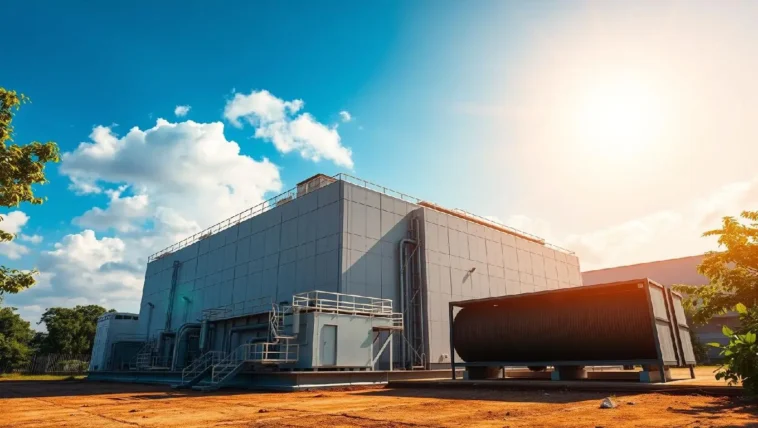Taraba Waste-to-power Plant
Taraba’s Green Power Revolution: 15MW Waste-to-Energy Plant
Taraba Waste-to-Power Plant promises a brighter, cleaner future for the state, harnessing waste to generate clean energy and stimulate economic growth.Taraba’s Trash-to-Treasure Gambit: Can a New Power Plant Spark a Green Revolution?
In a bold move signaling a potential paradigm shift in Nigeria’s approach to waste management and energy production, Taraba State has inked a 25-year agreement with SectorLead Limited. The ambitious project? A 15MW waste-to-power plant designed to convert the state’s mounting municipal solid waste into a source of clean, renewable energy. But can this initiative truly live up to its promise and catapult Taraba into the vanguard of Nigeria’s green revolution?
From Eyesore to Energy Source: Tackling Taraba’s Waste Woes Head-On
For too long, Taraba, like many states in Nigeria, has grappled with the unsightly and environmentally hazardous problem of overflowing landfills. These mountains of discarded refuse not only blight the landscape but also pose significant health risks to local communities. The new waste-to-power plant offers a tantalizing solution: transforming this liability into an asset.
Imagine a Taraba where waste is no longer a problem but a resource. A place where the air is cleaner, the environment healthier, and the energy supply more secure. This is the vision that Governor Agbu Kefas and his administration are hoping to realize with this groundbreaking project.
The state’s commitment to addressing its waste management challenges through innovative means is commendable. However, the success of this venture hinges on several factors, including efficient waste collection systems, community engagement, and the plant’s operational efficiency.
A Quarter-Century Commitment: Decoding the SectorLead-Taraba Partnership
The 25-year agreement between Taraba State and SectorLead Limited represents a significant long-term investment in sustainable energy. But what exactly does this partnership entail? SectorLead, a company specializing in renewable energy solutions, will be responsible for the design, construction, and operation of the 15MW waste-to-power plant.
The agreement, witnessed by key state officials, underscores the government’s commitment to the project. The presence of the Programme Director of Strategy and Portfolio Delivery Office, the Commissioner for Environment and Climate Change, and the Commissioner for Waste Management and Resource highlights the cross-departmental collaboration required for the project’s success.
For SectorLead, this project represents a major opportunity to showcase its expertise in waste-to-energy technology and establish itself as a key player in Nigeria’s burgeoning renewable energy sector. The company’s CEO, Adedayo Mustapha, has described the project as a “turning point” for Taraba State, emphasizing its potential to deliver significant environmental, economic, and energy benefits.
However, the success of this partnership will depend on transparency, accountability, and a shared commitment to achieving the project’s goals. Regular monitoring and evaluation will be crucial to ensure that the plant operates efficiently and delivers the promised benefits to the people of Taraba.
The Alchemy of Energy: Unpacking the Waste-to-Power Process
How exactly does a waste-to-power plant transform garbage into electricity? The process involves a series of sophisticated technologies that convert municipal solid waste into usable energy. While the specific technology used in the Taraba plant has not been detailed, waste-to-energy plants typically employ one of several methods, including incineration, gasification, and anaerobic digestion.
Incineration involves burning waste at high temperatures to produce steam, which then drives turbines to generate electricity. Gasification converts waste into a synthetic gas (syngas) that can be used to fuel gas engines or turbines. Anaerobic digestion uses microorganisms to break down organic waste in the absence of oxygen, producing biogas that can be used for power generation.
The choice of technology will depend on factors such as the composition of the waste stream, environmental regulations, and economic considerations. Regardless of the method used, the waste-to-power process offers a significant advantage over traditional waste disposal methods by reducing the volume of waste sent to landfills and generating clean energy in the process.
However, it is crucial to ensure that the plant is equipped with state-of-the-art pollution control technologies to minimize emissions of harmful pollutants. Public concerns about air quality and potential health impacts must be addressed through transparent communication and rigorous environmental monitoring.
Illuminating Taraba: A Green Solution to the State’s Power Deficit
Taraba State, like many parts of Nigeria, suffers from a chronic energy deficit. Erratic power supply has hampered economic development, stifled business growth, and disrupted daily life for residents. The 15MW waste-to-power plant offers a glimmer of hope, promising to boost the state’s energy supply and enhance energy security.
While 15MW may seem like a relatively small amount of power, it can make a significant difference in a state where access to electricity is limited. The plant’s output can be used to power homes, businesses, and public facilities, reducing reliance on expensive and unreliable generators.
Moreover, the waste-to-power plant offers a more sustainable alternative to traditional fossil fuel-based power generation. By utilizing a renewable energy source – municipal solid waste – the plant can help reduce Taraba’s carbon footprint and contribute to the fight against climate change.
However, it is important to note that the waste-to-power plant is not a silver bullet solution to Taraba’s energy challenges. A comprehensive approach is needed, including investments in other renewable energy sources, improvements to the state’s electricity grid, and measures to promote energy efficiency.
Beyond Kilowatts: The Economic Spark Ignited by Waste-to-Energy
The benefits of the Taraba waste-to-power plant extend far beyond energy production. The project is expected to create jobs during both the construction and operational phases, stimulating economic growth and improving livelihoods. From construction workers and engineers to plant operators and waste management personnel, the plant will generate a range of employment opportunities for local residents.
Moreover, the plant can attract further investment in Taraba’s renewable energy sector, creating a virtuous cycle of economic growth and sustainable development. The project can also serve as a catalyst for the development of other waste-related industries, such as recycling and composting.
The economic benefits of the waste-to-power plant are particularly significant in a state like Taraba, where unemployment and poverty rates are high. By providing jobs and stimulating economic activity, the plant can help improve the quality of life for thousands of people.
However, it is crucial to ensure that local communities benefit directly from the economic opportunities created by the project. This can be achieved through targeted training programs, preferential hiring policies, and community development initiatives.
Breathing Easier: The Environmental Payoff of Turning Trash into Power
One of the most compelling arguments for waste-to-energy plants is their potential to reduce carbon emissions and promote a cleaner environment. Traditional landfills are a major source of greenhouse gases, particularly methane, a potent climate pollutant. By diverting waste from landfills, the Taraba waste-to-power plant can significantly reduce these emissions.
Moreover, the plant can help reduce air and water pollution associated with traditional waste disposal methods. Landfills can contaminate groundwater and release harmful pollutants into the air, posing risks to human health and the environment. Waste-to-energy plants, when properly designed and operated, can minimize these risks.
The environmental benefits of the waste-to-power plant align with Nigeria’s national policies on climate change and sustainable development. The country has committed to reducing its greenhouse gas emissions and promoting the use of renewable energy sources. The Taraba project can serve as a model for other states looking to achieve these goals.
However, it is essential to conduct a thorough environmental impact assessment to identify and mitigate any potential risks associated with the plant’s operation. This assessment should include measures to minimize air and water pollution, protect biodiversity, and ensure the safe disposal of ash and other byproducts.
Ticking the Boxes: How Taraba’s Plant Aligns with Global Sustainability Goals
The Taraba waste-to-power plant is not just a local initiative; it is also a contribution to global efforts to achieve sustainable development. The project aligns with several of the United Nations Sustainable Development Goals (SDGs), particularly SDG 7 (Affordable and Clean Energy), SDG 12 (Responsible Consumption & Production), and SDG 13 (Climate Action).
By generating clean energy from waste, the plant helps to achieve SDG 7, which aims to ensure access to affordable, reliable, sustainable, and modern energy for all. By reducing waste sent to landfills and promoting responsible waste management practices, the plant contributes to SDG 12, which seeks to ensure sustainable consumption and production patterns.
By reducing greenhouse gas emissions and promoting the use of renewable energy, the plant supports SDG 13, which calls for urgent action to combat climate change and its impacts. The Taraba project demonstrates how local initiatives can contribute to global efforts to address some of the most pressing challenges facing humanity.
However, it is important to track the project’s progress and measure its impact on the SDGs. This can be achieved through regular monitoring and reporting, using indicators aligned with the SDG framework.
Nigeria’s Green Awakening: Is Waste-to-Energy the Next Big Thing?
The Taraba waste-to-power plant is part of a growing trend in Nigeria towards sustainable energy solutions. Several other states are also exploring the potential of waste-to-energy technology, recognizing its potential to address both waste management and energy challenges. A state-level assessment of waste-to-energy potential in Nigeria estimated that different states could generate between 31-205 MW of electricity, depending on their waste generation capacity.
However, despite this potential, the development of waste-to-energy projects in Nigeria has been slow. Challenges include poor waste collection efficiencies, lack of investment, and regulatory hurdles. A recent study estimated that Nigeria’s exploitable waste-to-energy capacity from municipal solid waste is below 3,800 GWh/year, with all states having less than 50 MW capacity.
The Taraba project can serve as a catalyst for the wider adoption of waste-to-energy technology in Nigeria. By demonstrating the viability and benefits of this approach, the project can encourage other states to invest in similar initiatives. The federal government can also play a role by providing incentives, streamlining regulations, and supporting research and development.
However, it is crucial to learn from past mistakes and avoid repeating the failures of previous renewable energy projects in Nigeria. This requires careful planning, transparent procurement processes, and effective project management.
Building on Success: Lessons from Kashimbila and Beyond
The Taraba waste-to-power plant is not the state’s first foray into renewable energy. The recent concession of the Kashimbila Dam to KP Hydro Limited marks another milestone in Taraba’s efforts to harness its natural resources for sustainable development. The Kashimbila Dam, a multipurpose project designed for irrigation, flood control, and power generation, has the potential to provide a significant boost to Taraba’s energy supply.
Governor Agbu Kefas has expressed optimism for investment in energy distribution and new hydro power projects, signing an MOU with China Civil Engineering Construction Corporation (CCECC) for energy projects. These initiatives demonstrate the state government’s commitment to diversifying its energy mix and promoting the use of renewable energy sources.
The success of the waste-to-power plant and the Kashimbila Dam project will depend on effective coordination and collaboration between government agencies, private sector partners, and local communities. It is also essential to address any potential social and environmental impacts associated with these projects.
By learning from past experiences and adopting best practices, Taraba can establish itself as a leader in renewable energy development in Nigeria.
A Vision for Tomorrow: Taraba’s Sustainable Energy Future
The Taraba waste-to-power plant represents more than just a project; it is a statement of intent. It signals Taraba’s commitment to building a sustainable future for its people, one where economic growth, environmental protection, and social well-being go hand in hand. The project has the potential to transform Taraba into a model for other states in Nigeria and across Africa.
But the journey towards a sustainable energy future is a long and challenging one. It requires sustained commitment, innovative thinking, and a willingness to embrace new technologies. It also requires the active participation of all stakeholders, including government, private sector, civil society, and local communities.
As Taraba embarks on this ambitious endeavor, it is important to remember that success is not guaranteed. There will be challenges and setbacks along the way. But by staying true to its vision and remaining committed to its goals, Taraba can overcome these obstacles and create a brighter, cleaner, and more prosperous future for all.
What’s your take on Taraba’s waste-to-power initiative? Share your thoughts and join the conversation below! Let’s discuss the potential of renewable energy in Nigeria and how we can all contribute to a more sustainable future.
As Taraba State takes bold steps towards a sustainable future, the innovative waste-to-power plant not only promises cleaner energy but also sparks a broader conversation about eco-friendly solutions. The commitment to renewable resources and responsible waste management reflects a growing global consciousness, with individuals and communities alike seeking ways to minimize their environmental footprint.
This wave of environmental awareness has fueled a surge in demand for products that support sustainable living. From home energy solutions to eco-friendly gadgets, consumers are increasingly eager to invest in technologies that reduce carbon emissions and promote a healthier planet. Are you ready to join the green revolution and discover how you can make a difference? Explore our curated selection of renewable energy systems and take the first step towards a more sustainable lifestyle. Don’t forget to share your thoughts on Taraba’s initiative in the comments below, and subscribe to our newsletter for the latest updates on green innovation!
Shop Products On Amazon
Shop Products on Ebay









Trending Similar Stories in the News
Taraba, firm sign agreement to establish waste-to-power plant The Nation Newspaper...
Court orders arrest of former Kano commissioner for justice, Lawan Businessday...
Trending Videos of Taraba Waste-to-power Plant
How it works - Waste-to-Energy
Similar Popular Articles
#renewableenergy #wastetoenergy #sustainabledevelopment #Taraba #Nigeria
Taraba, Waste-to-Energy, Renewable Energy, Sustainable Development, Nigeria






Taraba’s Green Power Revolution: 15MW Waste-to-Energy Plant
💬 What’s your take? Drop a comment below! ⬇️
#BreakingNews #LatestUpdate #StayInformed
📖 Read More: https://tinyurl.com/26txvplf